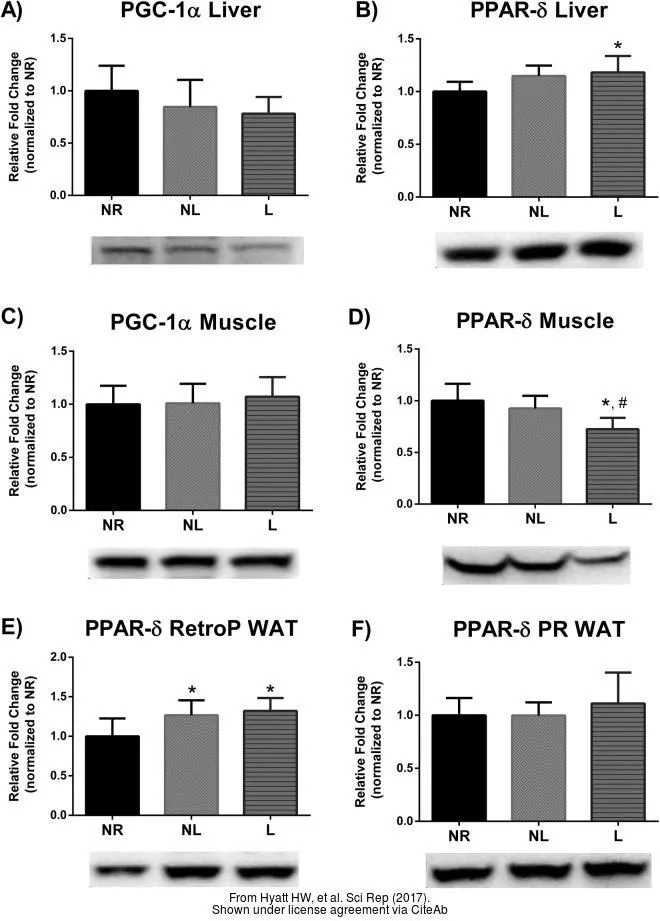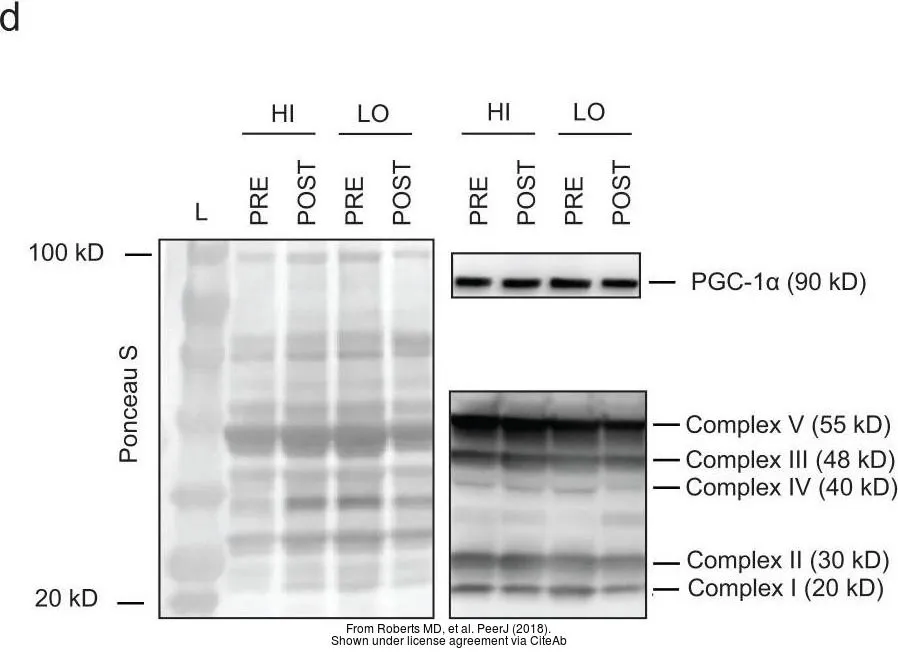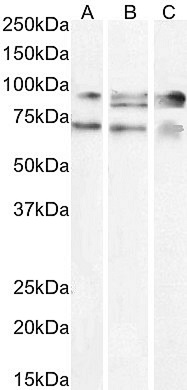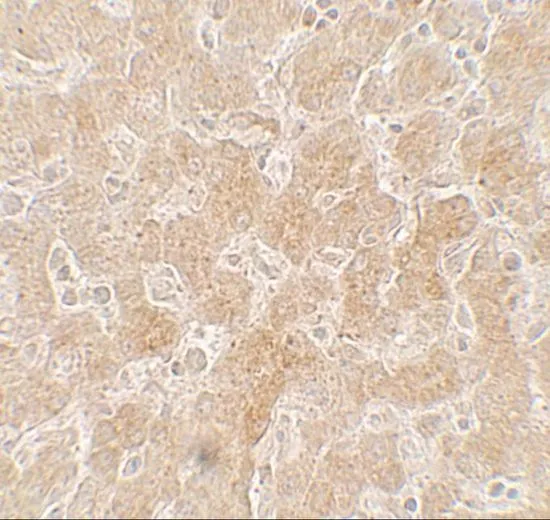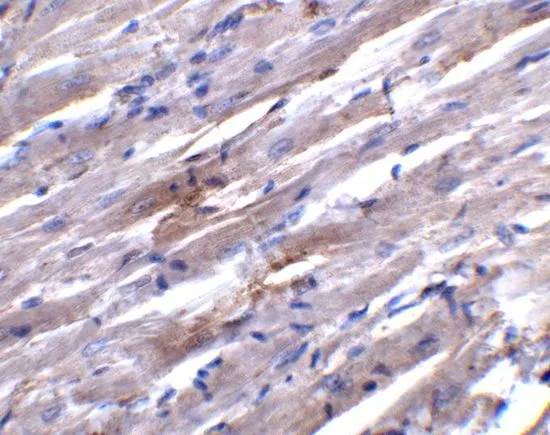
WB analysis of rat heart (Lane 1), mouse skeletal muscle (Lane 2), rat testis (Lane 3), mouse colon (Lane 4), rat thymus (Lane 5), mouse liver (Lane 6) tissue lysates using GTX37356 PGC1 alpha antibody. Dilution : 0.5microg/ml
PGC1 alpha antibody
GTX37356
ApplicationsWestern Blot
Product group Antibodies
TargetPPARGC1A
Overview
- SupplierGeneTex
- Product NamePGC1 alpha antibody
- Delivery Days Customer9
- Application Supplier NoteWB: 1:200-1000. *Optimal dilutions/concentrations should be determined by the researcher.Not tested in other applications.
- ApplicationsWestern Blot
- CertificationResearch Use Only
- ClonalityPolyclonal
- Concentration0.5 mg/ml
- ConjugateUnconjugated
- Gene ID10891
- Target namePPARGC1A
- Target descriptionPPARG coactivator 1 alpha
- Target synonymsLEM6, PGC-1(alpha), PGC-1alpha, PGC-1v, PGC1, PGC1A, PPARGC1, peroxisome proliferator-activated receptor gamma coactivator 1-alpha, L-PGC-1alpha, PGC-1-alpha, PPAR gamma coactivator variant form, PPARAGCIalpha, PPARGC-1-alpha, PPARgamma coactivator 1alpha, ligand effect modulator-6
- HostRabbit
- IsotypeIgG
- Protein IDQ9UBK2
- Protein NamePeroxisome proliferator-activated receptor gamma coactivator 1-alpha
- Scientific DescriptionThe protein encoded by this gene is a transcriptional coactivator that regulates the genes involved in energy metabolism. This protein interacts with PPARgamma, which permits the interaction of this protein with multiple transcription factors. This protein can interact with, and regulate the activities of, cAMP response element binding protein (CREB) and nuclear respiratory factors (NRFs). It provides a direct link between external physiological stimuli and the regulation of mitochondrial biogenesis, and is a major factor that regulates muscle fiber type determination. This protein may be also involved in controlling blood pressure, regulating cellular cholesterol homoeostasis, and the development of obesity. [provided by RefSeq, Jul 2008]
- Storage Instruction-20°C or -80°C,2°C to 8°C
- UNSPSC12352203
References
- Liang MZ, Lu TH, Chen L. Timely expression of PGAM5 and its cleavage control mitochondrial homeostasis during neurite re-growth after traumatic brain injury. Cell Biosci. 2023,13(1):96. doi: 10.1186/s13578-023-01052-0Read this paper
- Su WP, Li CJ, Lin LT, et al. Boosting mitochondrial function and metabolism in aging female germ cells with dual ROCK/ROS inhibition. Biomed Pharmacother. 2023,163:114888. doi: 10.1016/j.biopha.2023.114888Read this paper
- Mesquita PHC, Godwin JS, Ruple BA, et al. Resistance Training Diminishes Mitochondrial Adaptations to Subsequent Endurance Training. bioRxiv. 2023,:pii: 2023.04.06.535919. doi: 10.1101/2023.04.06.535919.Read this paper
- Mesquita PHC, Osburn SC, Godwin JS, et al. Effects of aging and long-term physical activity on mitochondrial physiology and redox state of the cortex and cerebellum of female rats. Physiol Rep. 2022,10(24):e15542. doi: 10.14814/phy2.15542Read this paper
- Zhang Y, Hill GE, Ge Z, et al. Effects of a Bacterial Infection on Mitochondrial Function and Oxidative Stress in a Songbird. Physiol Biochem Zool. 2021,94(2):71-82. doi: 10.1086/712639Read this paper
- Mesquita PHC, Lamb DA, Parry HA, et al. Acute and chronic effects of resistance training on skeletal muscle markers of mitochondrial remodeling in older adults. Physiol Rep. 2020,8(15):e14526. doi: 10.14814/phy2.14526Read this paper
- Hill GE, Hood WR, Ge Z, et al. Plumage redness signals mitochondrial function in the house finch. Proc Biol Sci. 2019,286(1911):20191354. doi: 10.1098/rspb.2019.1354Read this paper
- Garnham JO, Roberts LD, Caspi T, et al. Divergent skeletal muscle mitochondrial phenotype between male and female patients with chronic heart failure. J Cachexia Sarcopenia Muscle. 2020,11(1):79-88. doi: 10.1002/jcsm.12488Read this paper
- Parry HA, Mobley CB, Mumford PW, et al. Bovine Milk Extracellular Vesicles (EVs) Modification Elicits Skeletal Muscle Growth in Rats. Front Physiol. 2019,10:436. doi: 10.3389/fphys.2019.00436Read this paper
- Parry HA, Kephart WC, Mumford PW, et al. Ketogenic diet increases mitochondria volume in the liver and skeletal muscle without altering oxidative stress markers in rats. Heliyon. 2018,4(11):e00975. doi: 10.1016/j.heliyon.2018.e00975Read this paper

